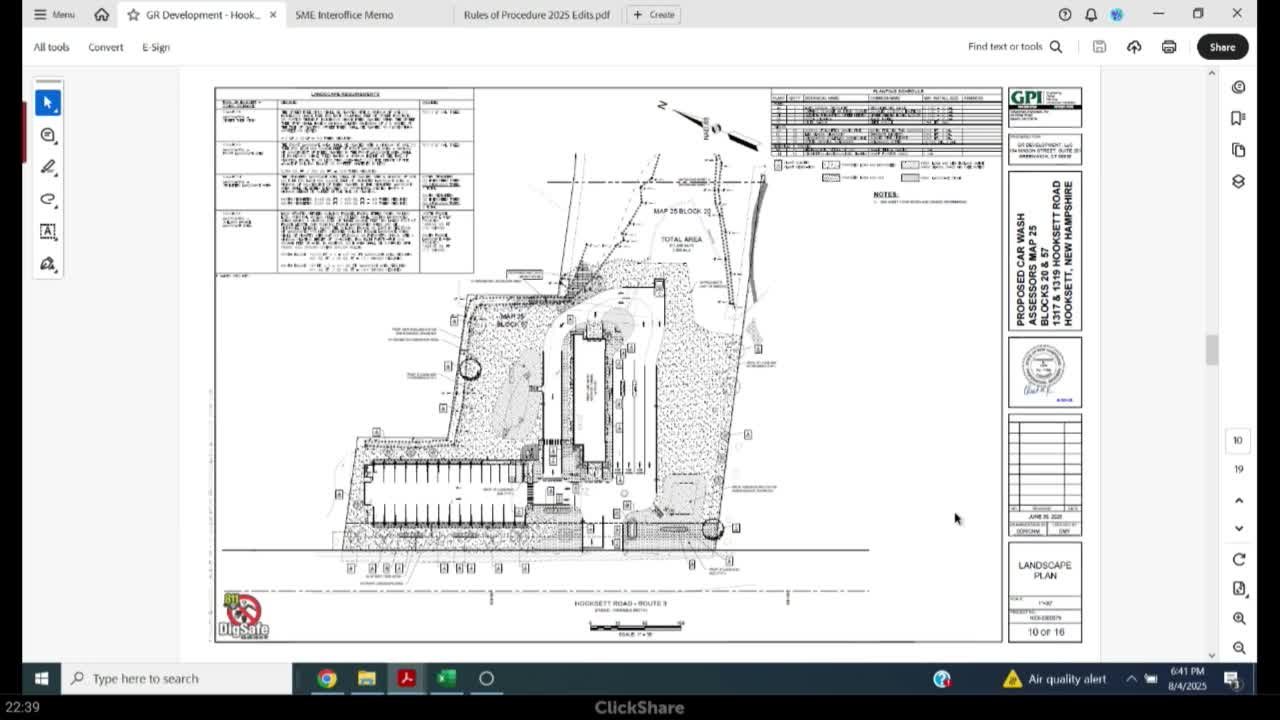Planning Board Weighs Wetland Regulations and Architectural Concerns for New Car Wash
August 04, 2025 | Hooksett, Merrimack County , New Hampshire
This article was created by AI summarizing key points discussed. AI makes mistakes, so for full details and context, please refer to the video of the full meeting. Please report any errors so we can fix them. Report an error »

In the heart of Hooksett, New Hampshire, the Planning Board convened on August 4, 2025, to discuss a proposed car wash project that has sparked both interest and concern among board members. The meeting unfolded with a focus on the project's environmental impact, landscaping choices, and architectural design, reflecting the community's desire for thoughtful development.
As discussions began, the developers emphasized the importance of obtaining preliminary approvals from both the Planning Board and the Conservation Commission before proceeding to the state Department of Environmental Services (DES) for a wetland application. This step is crucial, as the project site includes sensitive wetland areas. Board members expressed appreciation for the developers' proactive approach in seeking their input early in the process.
Landscaping emerged as a significant topic of debate. One board member voiced a preference for trees over shrubs in the front of the property, citing aesthetic concerns about the visibility of vacuum stations. The desire for a greener landscape was echoed by others, who noted that mature trees could provide a natural buffer and enhance the overall appearance of the site. The conversation highlighted a broader concern about maintaining the character of the area, especially given past instances of tree removal that had altered the landscape.
Architectural design also took center stage, with board members questioning whether the proposed car wash model was the best fit for the location. Some expressed skepticism about the demand for another car wash in an area already populated with similar businesses. The developers defended their investment, citing their experience with successful models in other towns and the potential for a thriving business in Hooksett.
The board's discussions revealed a tension between supporting new business ventures and ensuring that developments align with community standards and environmental considerations. Members sought data to substantiate the developers' claims about market demand, suggesting that comparative studies from similar-sized towns could bolster their case.
As the meeting drew to a close, the board agreed on the need for further exploration of architectural options, including a request for renderings of different styles that might better suit the community's aesthetic preferences. The developers were encouraged to return with revised plans that incorporated more greenery and a design that resonated with the local character.
This meeting underscored the delicate balance between fostering economic growth and preserving the unique identity of Hooksett. As the Planning Board prepares for future discussions, the outcome of this project remains uncertain, but the commitment to thoughtful planning and community engagement is clear.
As discussions began, the developers emphasized the importance of obtaining preliminary approvals from both the Planning Board and the Conservation Commission before proceeding to the state Department of Environmental Services (DES) for a wetland application. This step is crucial, as the project site includes sensitive wetland areas. Board members expressed appreciation for the developers' proactive approach in seeking their input early in the process.
Landscaping emerged as a significant topic of debate. One board member voiced a preference for trees over shrubs in the front of the property, citing aesthetic concerns about the visibility of vacuum stations. The desire for a greener landscape was echoed by others, who noted that mature trees could provide a natural buffer and enhance the overall appearance of the site. The conversation highlighted a broader concern about maintaining the character of the area, especially given past instances of tree removal that had altered the landscape.
Architectural design also took center stage, with board members questioning whether the proposed car wash model was the best fit for the location. Some expressed skepticism about the demand for another car wash in an area already populated with similar businesses. The developers defended their investment, citing their experience with successful models in other towns and the potential for a thriving business in Hooksett.
The board's discussions revealed a tension between supporting new business ventures and ensuring that developments align with community standards and environmental considerations. Members sought data to substantiate the developers' claims about market demand, suggesting that comparative studies from similar-sized towns could bolster their case.
As the meeting drew to a close, the board agreed on the need for further exploration of architectural options, including a request for renderings of different styles that might better suit the community's aesthetic preferences. The developers were encouraged to return with revised plans that incorporated more greenery and a design that resonated with the local character.
This meeting underscored the delicate balance between fostering economic growth and preserving the unique identity of Hooksett. As the Planning Board prepares for future discussions, the outcome of this project remains uncertain, but the commitment to thoughtful planning and community engagement is clear.
View full meeting
This article is based on a recent meeting—watch the full video and explore the complete transcript for deeper insights into the discussion.
View full meeting
